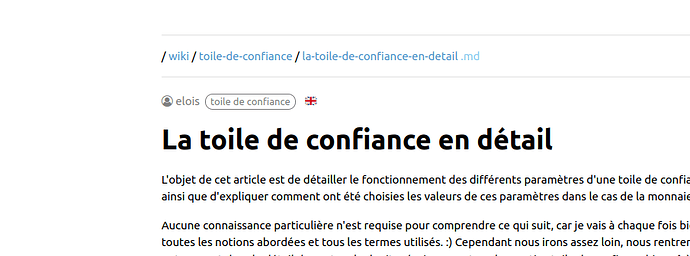Bonjour,
J’aimerai bien récupérer tout le code de la page “Duniter | La toile de confiance en détail”, le traduire avec chat GPT ou WriteSonic pour remettre directement le code traduit dans la page Duniter | Web of trust
Comment éditer le wiki?
Est-ce qu’il me faut un accès gitlab?
Il y a déjà une traduction : Duniter | Deep-dive into the Web of Trust
Mais apparemment il n’y a pas la redirection depuis la version française, et elle n’est pas mentionnée dans la page Web of Trust.
Il y a un petit drapeau ![]() qui mène à la traduction.
qui mène à la traduction.
Le lien était effectivement cassé, la cible est : https://duniter.org/wiki/web-of-trust/deep-dive-wot/
→ websites / duniter_website_fr_v2 · GitLab
→ websites / duniter_website_en_v2 · GitLab
Bien vu et merci pour la remarque, c’est en fait au moment de la migration : certaines images étaient au même endroit, d’autre avaient été renommées /PELICAN/images/wiki/toile-de-confiance/degres.jpg → /PELICAN/images/wiki/degrees.jpg. Donc le problème est valable pour tout le site et je vais essayer de corriger tout d’un coup. Dommage que Zola n’ait pas d’option pour checker les liens vers des fichiers statiques ![]() (ça ferait une jolie contribution)
(ça ferait une jolie contribution)
[edit] c’est réparé normalement, est-ce que tu confirmes, @Chrisaiki ? Duniter | Deep-dive into the Web of Trust
le lien " read more about web of trust" de Duniter | Wiki ne donne sur rien et la page Duniter | Deep-dive into the Web of Trust n’est reliée a rien, du coup y a encore du bouleau ![]()
Oui, en effet, beaucoup des infos étaient organisées sous forme d’articles de blog. Pour duniter.fr j’ai fait un boulot de “colle” pour organiser plutôt sous forme de documentation, mais il faudrait reprendre ce travail pour l’améliorer et ensuite le traduire sur duniter.org.
Il est aussi possible de traduire tout de suite comme tu proposes, et de mettre à jour ensuite quand le contenu sera amélioré.
Traduction chatGPT de la page Duniter | Toile de confiance
The Web of Trust
The Web of Trust is the best way we have found to ensure that each person can only create a portion of the currency. To join, one must be recommended by five members and comply with a few additional rules which you can find details about in this section. This system does not guarantee a 100% absence of fraud, but significantly limits its scope.
How the Web of Trust Works
The Web of Trust in Detail
How to Certify New Members
Frequently Asked Questions about the Web of Trust
Traduction de la page Duniter | Certifier de nouveaux membres
Certifying New Members
How does one become a member of the Web of Trust?
Once you become a member, you gain the right to certify new candidates for the Ğ1 Web of Trust. This means that you can help new people become members of the Ğ1 Web of Trust.
How to Certify New Members
For a person to join the Ğ1 Web of Trust, they must obtain a minimum of 5 certifications. Therefore, they will seek to obtain these 5 certifications from current members of Ğ1, including you.
You may agree to provide a certification to this person, and even to several others. With the help of 4 other members, this person can become a member in turn.
Certification is not taken lightly!
However, it is not about giving certifications casually or to please others. As a new member, you have studied and accepted the Ğ1 license. You understand that it is important to know the person you are certifying, and that your own responsibility as a member is involved in this process towards other members of the Ğ1 Web of Trust.
Especially if you certify a person who already has an account or certify a fake identity, this creates a prejudice for the rest of the Ğ1 Web of Trust.
It is important to be aware that certification, as well as identity, are public and verifiable data. Thus, creating false identities and false links in the web could easily be detected and publicly revealed, leading to sanctions taken by the Ğ1 community, particularly in terms of excluding cheaters and their accomplices.
Some practical tools
With these remarks in mind, there are 2 tools to help you “see” who is waiting for certifications, how many have been received, and what the distance of this member is from the web.
Monitor Pending Certifications
The willMembers tool from ğ1-monit allows you to see members waiting for certification and the number of certifications already received.
Furthermore, the tool can identify any potential duplicate accounts.
Knowing the distance between members
The Wotex tool allows you to see the distance between members.
For now, the so-called “distance” rule does not have a strong impact, as the network is still small (less than 3000 members). So today, newcomers only need to get 5 certifications, no matter who gives them.
But in the near future, this distance rule will start to apply: obtaining 5 certifications may not be enough if they do not meet the distance criterion.
What is this criterion? It states that every member must be reachable by any other member through their 5 certifications. This means that there must be at least 1 path starting from each referring member and leading to the new member through the paths of the network, including certifications to the new member. And this must be true for 80% of referring members.
A referring member is a member of the network who has issued and received at least X certifications, where X depends on the number of members. Currently, for 100 members, X is 3. So any member who has issued and received 3 certifications is a referring member, and the distance rule applies to any new member with respect to them.
